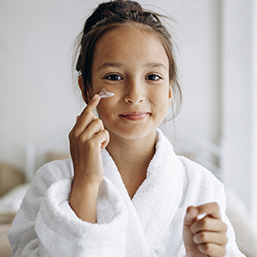
Adolescence, a time of physical and emotional changes and fragile self-esteem, can be made even more troubling by those dreaded lumps and bumps… acne.
Usually between the ages of ten and 13, the first pimples, whiteheads, and blackheads appear in about 85 percent of teens. As a result of the hormonal changes which occur in adolescence, particularly due to androgens, oil glands in the skin begin working overtime producing more sebum and blocking pores. There appears to be a deep skin bacteria which contributes to the production of pimples. There can be inflammation from this bacterial overgrowth, causing redness and more painful, deeper lesions.
Furthermore, there is an inherited aspect to acne and thus if you suffered from acne as a teen, your children also will likely suffer. So, what can you do to make your child's experience with acne more pleasant than your own?
It should be made clear to your teenagers that acne is not caused by poor hygiene. In fact, washing the face too often, scrubbing too vigorously, or using harsh cleansers can make acne worse. Discourage picking or squeezing pimples and blackheads, as this can inflame them further and cause scarring. Acne is not caused by eating foods like chocolate or greasy foods. Perhaps, however, if a teen eats a lot of greasy foods and touches the face, oils can be deposited there from the hands and further block pores. Therefore, discourage your teen from touching their face and ensure makeup, moisturizers, and sunscreen are oil-free/non comedogenic.
The treatment of acne involves a step-wise approach depending on the severity and response of the acne. For very mild cases, over-the-counter products containing benzoyl peroxide, salicylic acid, or tea tree oil are often effective, in addition to a cleansing routine of washing the face twice per day with a non-perfumed, gentle cleanser. Over-the-counter products can take up to three months to work, so patience is key. If there is no response to these products, see your doctor regarding the prescription alternatives. These choices may include topical creams such as antibiotic creams, vitamin A (or retinoid) creams, stronger benzoyl peroxide creams, salicylic acid, tazarotene, adapalene, and creams that offer a combination of these choices to treat the acne on a number of fronts. The key with all of these creams is to apply them to the entire face, rather than spot treatment, to prevent the pimples from forming in the first place.
For more severe or cystic acne, your doctor may prescribe oral antibiotics, in pill form, in addition to creams. The birth control pill or spironolactone is sometimes used to control acne, by blocking the effect of androgens on the skin. For the most severe cases involving cysts and scarring, your doctor may prescribe isotretinoin, a pill related to vitamin A. It has a number of trade names including Accutane, Claris, or Epuris. It is extremely effective, and can effectively cure acne. It has many possible side effects, including potential birth defects, and causes extreme dryness of the skin and lips. Blood tests must be done to monitor the liver and cholesterol levels on isotretinoin. The usual course of therapy is six to nine months.
With the variety of products currently available to treat acne, it need not be the devastating condition it was in our youth. See your doctor before those blemishes affect your teen's self confidence.
Dr. Kathy Savoia is a family physician and the mother of two beautiful girls.
See our related articles:
Calgary’s Child Magazine © 2024 Calgary’s Child